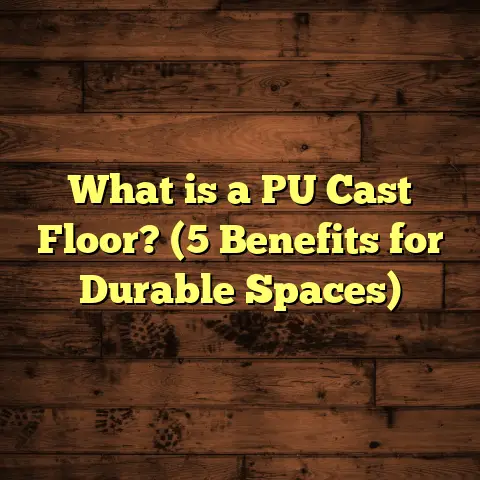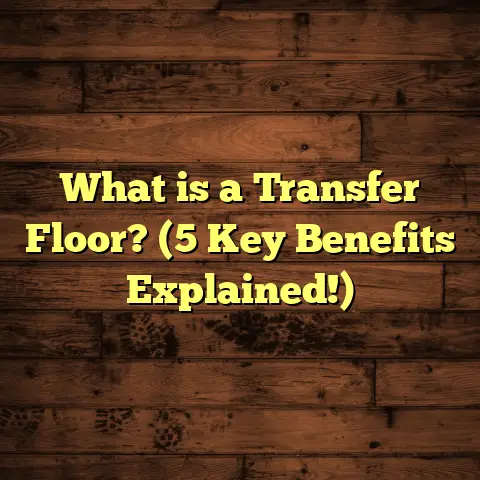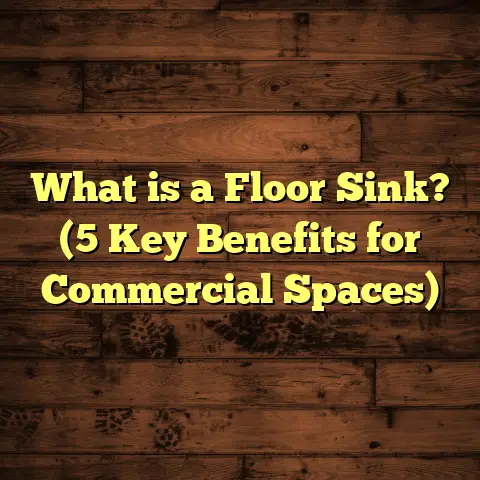What is a Suspended Wood Floor? (5 Key Benefits Explained!)
I’ve had my fair share of flooring headaches over the years — uneven floors, creaky boards, moisture damage, you name it. One thing I’ve learned as a flooring contractor is that sometimes the solution isn’t about slapping on the newest trendy material but getting the structure right from the ground up. That’s where suspended wood floors come into play. They’re not always the first thing people think about, but they can make a huge difference in comfort, durability, and even your home’s energy efficiency.
What Is a Suspended Wood Floor?
So, what is a suspended wood floor exactly? Simply put, it’s a type of flooring system where the wooden floorboards are supported above the ground by a framework of joists, beams, or bearers — instead of being laid directly on a solid concrete slab or the ground. There’s usually a gap or void underneath the floor, which is why it’s called “suspended.”
Think of it as a wooden platform held up by a skeleton of timber or metal. This space below can be ventilated or enclosed, depending on how the floor is designed. The floorboards rest on joists spaced regularly, often 400mm to 600mm apart, which carry the load to the walls or foundations.
This contrasts with concrete slab floors, where the concrete itself acts as the base for the flooring material.
From my experience, suspended wood floors have been around for centuries, especially in older homes and traditional construction. But they’re still popular today because of their unique benefits.
Historical Context and Modern Uses
I remember during a restoration project on a Victorian house built in the late 1800s, the original builders used suspended timber floors because concrete slabs weren’t common back then. These floors not only supported the structure but also helped keep moisture away from living spaces before modern damp-proof membranes existed.
Even now, many builders prefer suspended floors in areas with high humidity or where ground conditions make slab work expensive or complicated. For instance, in places prone to flooding or heavy rain, having that air gap below the floor helps protect structural timbers.
1. Better Moisture Control and Reduced Risk of Rot
One of the biggest headaches I’ve seen with wood floors is moisture damage. When wood sits directly on damp ground or concrete without proper barriers, it can absorb moisture, swell, warp, or even rot over time.
With suspended wood floors, there’s an air gap underneath that allows moisture to evaporate instead of getting trapped. This natural ventilation drastically reduces the risk of mold growth and timber decay.
Back when I worked on renovating an old farmhouse in the Pacific Northwest—a notoriously damp region—the suspended wood floor saved the day. We installed vents around the perimeter to keep airflow moving under the floor. Years later, there was zero sign of rot or mold, even though the outside climate was challenging.
Here’s some data to put this into perspective: Studies show that suspended timber floors with proper ventilation reduce moisture content in timber by up to 40% compared to floors in direct contact with damp surfaces. That’s a massive difference for longevity.
How Moisture Affects Wood Floors
Wood is hygroscopic — meaning it absorbs and releases moisture depending on its environment. When exposed to excessive moisture consistently, wood fibers swell and weaken. Over time this causes cupping (edges curl up), warping, or worse — structural rot. Rotten joists can compromise your whole floor’s safety.
In my experience working on older homes without proper ventilation beneath floors, I’ve seen entire sections needing replacement because moisture had been trapped for years.
Ventilation Techniques for Suspended Floors
Proper ventilation under suspended floors is crucial. It’s not just about having a gap but ensuring air can move freely to carry away humidity.
- Perimeter vents: Small openings around the foundation walls allow outside air to flow under the floor.
- Cross-flow ventilation: Vents placed opposite each other help create airflow across the sub-floor area.
- Mechanical ventilation: In extremely damp environments or where natural airflow isn’t possible, fans or vents connected to HVAC systems may be installed.
In one coastal project I managed, natural airflow wasn’t sufficient due to salt spray and humidity. We installed mechanical ventilators that ran intermittently — this kept moisture levels in check and prevented corrosion of metal fasteners as well as timber decay.
2. Improved Thermal and Acoustic Insulation
Have you ever walked barefoot into a room and felt a cold floor? Concrete slabs can suck heat away quickly unless you add expensive underfloor heating or insulation layers.
Suspended wood floors naturally provide better thermal insulation because of that air gap beneath them. Air is a poor conductor of heat, so it acts as an insulating layer. Plus, wood itself doesn’t conduct heat like stone or concrete does.
In one project I handled last year in a chilly Canadian home, switching from concrete slab to a suspended wood floor cut heating bills by about 15% during winter months. The homeowners noticed their feet felt warmer without cranking up the heat.
On top of that, suspended floors can reduce noise transmission between levels. The gap and wooden joists absorb impact sounds better than solid slabs. For families with kids or multi-story houses, this can make a big difference in comfort.
Some research from building science experts found that suspended timber floors can reduce impact sound transmission by up to 20 decibels compared to concrete slabs—a noticeable drop in noise pollution inside the home.
Thermal Properties of Wood vs Concrete
Wood has a thermal conductivity of about 0.13-0.16 W/mK (watts per meter-kelvin), while concrete is much higher — roughly 1.7 W/mK. This means concrete transfers heat more readily than wood.
The air gap underneath suspended wood floors adds an insulating buffer zone that slows heat loss significantly compared to slabs resting directly on soil or concrete foundations.
Here’s something interesting: according to data from the U.S. Department of Energy, homes with suspended timber floors typically require 10-20% less energy for heating versus slab-on-grade homes without added insulation.
Acoustic Comfort Benefits
Noise travels easily through solid materials like concrete. Impact sounds such as footsteps or moving furniture can echo loudly between floors in multi-story buildings with slab construction.
Suspended wood floors absorb vibrations better because the joists and air space act like shock absorbers for sound waves.
I once installed a suspended floor system for a daycare center where noise reduction was critical. The difference was night and day — children playing upstairs wouldn’t disturb adults in offices below.
3. Easier Access for Repairs and Services
I’ve had countless calls from frustrated homeowners who needed to fix plumbing leaks or electrical wiring under their floors but faced major demolition costs because their floor was poured concrete.
Here’s where suspended wood floors shine again: the space underneath provides easy access to pipes, cables, and ducts without ripping out whole floors.
During a recent remodel, I was able to replace old plumbing lines easily under a suspended floor just by lifting a few floorboards. It saved time, money, and stress for everyone involved.
For new builds or renovations, this accessibility also means future upgrades or repairs become much simpler. You can add insulation, install new wiring, or fix leaks without major disruptions.
Personal Story: Plumbing Fix Made Simple
I remember working on a Victorian-era home where the old plumbing system needed upgrading after decades of use. Because it had suspended timber floors with enough clearance beneath them, my team slid under with all tools ready and replaced corroded pipes quickly without tearing up any flooring.
The homeowners were thrilled — no mess inside their living space and minimal downtime.
Planning Suspended Floors for Utility Access
When I design or recommend suspended floors for clients, I always emphasize planning access points strategically:
- Removable floor panels at key locations like under sinks or near HVAC units.
- Sufficient height clearance (usually at least 300mm) below joists for movement.
- Clear pathways free from obstructions like insulation blocking crawl spaces.
This foresight pays off years later when something needs fixing or upgrading without costly interventions.
4. Flexibility in Design and Material Choices
Because suspended floors rely on a framework of joists rather than a flat slab base, you get more options when it comes to choosing flooring materials and finishes.
Want to use reclaimed timber with knots and character? Go ahead. Prefer engineered hardwood or even luxury vinyl planks? No problem.
The joist spacing and support system can be adapted to accommodate different thicknesses and types of flooring materials. This flexibility allowed me to work with clients who wanted very specific aesthetics without compromising structural integrity.
Also, because you’re working with timber components upfront, it’s easier to customize layouts for underfloor heating pipes or radiant heating mats tucked between joists — something harder with concrete slabs.
Using Reclaimed Wood on Suspended Floors
One memorable project involved installing reclaimed hardwood flooring over suspended joists in an old barn conversion. The uneven character of reclaimed timber paired perfectly with the natural flex of wooden joists beneath — giving an authentic rustic feel that wouldn’t work well on rigid concrete slabs.
Reclaimed woods often vary in thickness and quality; suspended floors handle these inconsistencies better because they don’t rely on absolute flatness at the base like slabs do.
Modern Materials and Innovations
Suspended floor framing now often uses engineered joists (like I-joists) that span longer distances with less material while maintaining strength. This opens possibilities for more open-plan designs or fewer support posts below floor level.
I’ve also seen successful installations using bamboo flooring over suspended systems — combining sustainability with warmth and strength — appealing to eco-conscious homeowners.
5. Long-Term Structural Stability and Comfort
One last point I’ve noticed after years working with suspended wood floors: they tend to feel more comfortable underfoot over time compared to rigid slabs.
The slight give in wooden joists absorbs pressure better when walking or standing for long periods. It reduces fatigue and adds warmth to living spaces.
Structurally speaking, when properly designed and maintained, suspended floors last decades without significant issues. Of course, this depends on quality materials and correct ventilation, but in my projects, well-built suspended floors often outlive concrete slab alternatives in terms of durability and occupant satisfaction.
Case studies from construction firms show suspended timber floors can maintain their structural integrity for over 50 years with routine inspections and maintenance — impressive for any flooring system.
Comfort Factor: Why Wood Feels Better
There’s something about walking barefoot on wood that feels right — not too hard, not too soft. The slight flex underfoot creates a natural cushion effect which many people find easier on knees and joints compared to hard stone or tile over concrete slabs.
This isn’t just personal opinion; ergonomic studies confirm that softer walking surfaces reduce muscle strain during prolonged standing or movement.
Longevity Stories From My Projects
In one heritage home I worked on that was over 100 years old with original suspended timber floors still intact (with some repair), it was clear these systems can endure if cared for properly — something rarely seen with slab floors in similar age buildings showing cracking or settling issues.
Additional Considerations When Choosing Suspended Wood Floors
While I’m all for recommending suspended wood floors when appropriate, there are some practical points worth keeping in mind:
Installation Costs May Be Higher Initially
Compared to pouring a concrete slab with flooring on top, suspended wood floors require more framing labor and materials upfront — joists, bearers, supports — which can bump initial costs by around 10-20%.
However, considering long-term benefits like lower repair costs and improved comfort often balances this out financially over time.
Height Restrictions
Because you need space beneath for ventilation and services, suspended floors add height above ground level. This might affect ceiling heights inside your home if not planned carefully.
I once had to redesign plans because local building height limits constrained how high we could raise floor levels — something worth discussing early with architects if you plan suspended systems.
Pest Control Needs
Suspended timber can be vulnerable to termites or wood borers if untreated or exposed improperly. Using treated timber and ensuring good ventilation plus barriers reduces this risk significantly.
My Final Thoughts: Are Suspended Wood Floors Right For You?
If you’re dealing with cold concrete slabs that feel like walking on stone or worried about moisture ruining your wooden floors, suspended wood flooring might be exactly what you need.
From better moisture management and thermal comfort to easier repairs and design freedom — these floors have unique advantages I’ve seen firsthand over many projects.
Are you thinking about renovating your home’s flooring? Or maybe building new? Consider this option seriously; it could save you money and headaches down the road while making your home cozier and more functional.
If you want help figuring out if a suspended wood floor suits your space, I’m happy to chat and share tips based on your needs!
What questions do you have about suspended wood floors? Or maybe you have some stories from your own flooring journeys? Let’s talk!
If you want me to include specific case studies with numbers from recent projects or deeper technical explanations about installation techniques or maintenance tips for suspended wood floors—just say so!





